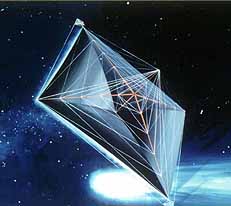(32) Far-out Pathways to Space: Solar SailsGradual acceleration by low thrustThe biggest hurdle for spaceflight is the first step: getting off the ground into some stable orbit above the dense atmosphere. Be it by rocket, gun or nuclear power, that step is the hardest, requiring a concentrated expenditure of energy and propellant mass. The initial orbit is generally the lowest one possible, the one requiring the smallest thrust. But the final goal could be a higher orbit, the Moon, a planet or comet, or even some target outside the solar system. The thrust needed to reach the final orbit from the initial one does not have to be delivered in a single, powerful blast: gradual acceleration will also work, which opens the door to alternative, more efficient methods of propulsion. The Solar Sail
One such method is the use of a solar sail, relying on the pressure of sunlight. That pressure (together with the pressure of the solar wind) makes comet tails point away from the Sun--not only when the comet approaches the Sun and its tail trails behind it, but also after it has passed the Sun and moves away, when the tail stretches ahead of the comet. The solar sail uses this pressure in much the same way as a sailing ship uses the wind. It would consist of a large sheet of reflective material, such as the mylar film which is used to keep spacecraft from overheating, and a framework of girders to keep it extended and to transmit its pressure to the spacecraft. Various designs have been proposed. Making the sheet reflective like a mirror is important. Sending most of the light back (nearly) doubles the pressure when the sail squarely faces the Sun. But more important, the sail can be tilted at an angle to the Sun's rays and reflect them in some chosen direction,. e. g. in the direction opposite from the one in which the spacecraft is moving, which gradually increases the velocity of the spacecraft. When the sail faces the Sun squarely, the pressure of sunlight counteracts the Sun's pull and only enables the satellite to circle the Sun in a slightly larger orbit. On the other hand, placing it at an angle can put the spacecraft on an outward or inward spiral, trajectories useful for interplanetary missions. A solar sail can also be useful for a monitoring spacecraft, placed to warn Earth of approaching "storms" from the Sun at a greater distance from Earth than the Lagrangian L1 point where such spacecraft are usually placed (details here). In general, solar sails are only expected to be useful where sunlight is sufficiently intense, e. g. inside the orbit of Mars. However, Robert Forward, science fiction author and physicist, has proposed the use of a solar sail in trips to the distant stars. In "Flight of the Dragonfly" a team of brave astronauts sets off in a starship to the water-covered half of Roche, a strange double planet inhabited by intelligent whale-like creatures. The starship is propelled by a huge solar sail, pushed by tight beams of light from lasers which are powered by sunlight and orbit the Sun. As the craft approaches its target, part of the sail is cut free. The laser beams then push it ahead of the starship, and as those beams are reflected back, they hit the remaining solar sail from the opposite direction, slowing down the ship and allowing its passengers to land. Let it never be said that scientists are too convention-bound and incapable of far-out ideas! In a technical appendix to the book, Forward presents the technical details of his fantasy. |



